Common Bird Species Identification Guide
1/68
Earn XP
Description and Tags
This set of flashcards provides definitions and key characteristics of various bird species commonly found in the Cache Creek Nature Preserve.
Name | Mastery | Learn | Test | Matching | Spaced |
|---|
No study sessions yet.
69 Terms
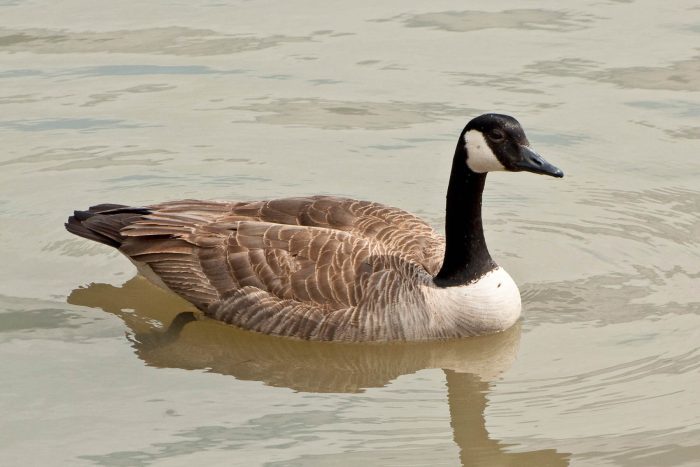
Canada Goose
Branta canadensis, a large waterbird known for its black and white head, and light brown body.
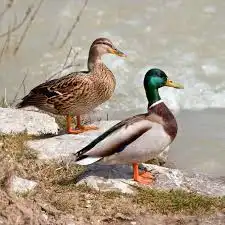
Mallard Duck
Anas platyrhynchos, characterized by a male with a white and grey body, green head, and yellow beak.
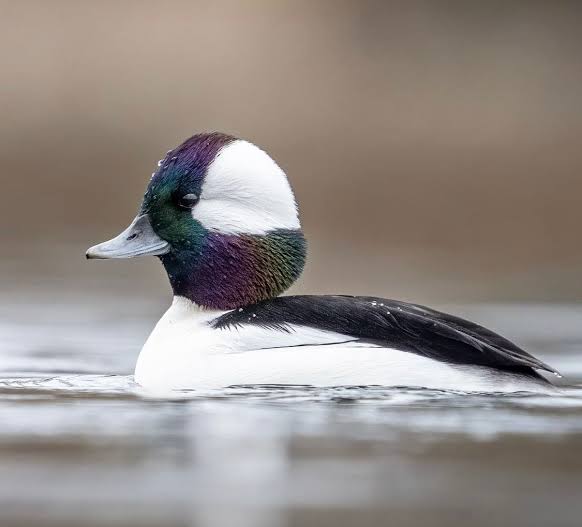
Bufflehead
bufflehead is a small sea duck of the genus Bucephala, the goldeneyes. It breeds in Alaska and Canada and migrates in winter to southern North America. This species was first described by Carl Linnaeus in his landmark 1758 10th edition of Systema Naturae as Anas albeola.
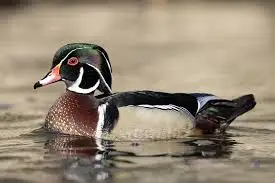
Wood Duck
Aix sponsa, a duck known for its iridescent feathers and unique coloration in males.
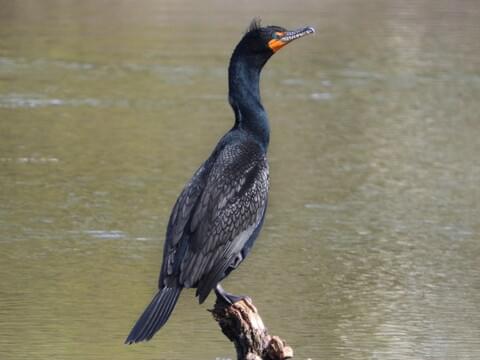
Double-crested Cormorant
Phalacrocorax auritus, a large waterbird with a long neck and thin, hooked bill.
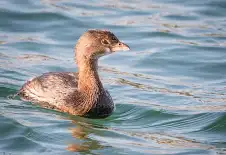
Pie billed grebe
No difference between males and females
It has a white ring surrounded by a black eye with the brown and grey body
Usually stay in ponds
can trap water in their feathers, giving them great control over their buoyancy. They can sink deeply or stay just at or below the surface, exposing as much or as little of the body as they wish.
Sound: nelegant repertoire of sounds ranging from guttural grunts, to loud squawks and honks like a goose, to rolling growling noises
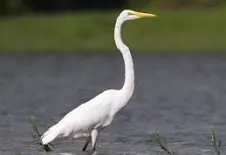
Great Egret
Ardea alba, a large white bird with a long neck and yellow beak.

Snowy Egret
all white body with a black bill, black legs, and yellow feet. They have a patch of yellow skin at the base of the bill.
Males and females are identical but males are larger
They nest in shrubs
Sound: Snowy Egrets are quiet except on breeding sites, where they give raspy or nasal calls, including loud, harsh squawks to signal aggression.
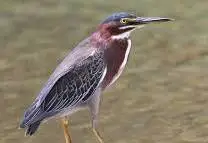
Green Heron
they are deep green on the back with a rich chestnut breast and neck
Has yellow feet and a very long pointy bill
Males and females are very similar, but the males are larger and darker in color due to sexual selection
Sound: harsh, explosive skeow call that, once learned, is a distinctive sound of wetlands.

Great Blue Heron
Large size, blue-gray plumage, long legs and neck, a distinctive black stripe over the eye, and shaggy plumes, especially during breeding season.
Long-thick pointy bill for counting prey
while males are slightly larger, both males and females have similar plumage, but males have longer ornamental plumes during breeding season.

Black-Crowned Night Heron
medium-sized heron with a stocky build, black crown, gray body and bright, red eyes
Males and females are similar, but the
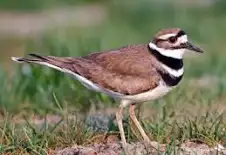
Killdeer
Brown body with white and black patches on its head area
brown upperparts, white underparts, a distinctive double black breast band, and a bright orange-red ring around their eyes
Fluffs up its body and is an excellent swimmer
Sound: their sound is very noticeable and very cute and high pitched sounding (uhm um uhm uhm)
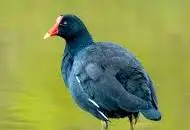
Common Gallinule
by its slate-gray plumage, bright yellow legs, a white flank stripe, and a distinctive red frontal shield above its red bill with a yellow tip
Very rotund-shaped
Males and females are very similar, but males slightly larger
all sorts of chickenlike clucks, whinnies, cackles, squawks, and yelps. They often call while hidden from view
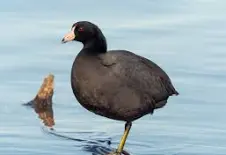
American Coot
Fulica americana, a bird with an all-black body and a distinctive pink beak.
All black bird with dark black head and pink beak and yellow legs
Eat plants in the water
Males and females: males have stronger plumage and display
Sound: variety of grunting, croaking, and squawking noises.
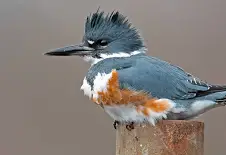
Belted Kingfisher
Blue bird with yellow and white patch and head Looks like a mohawk , point beak
stocky, large-headed birds with a shaggy crest on the top and back of the head and a straight, thick, pointed bill. Their legs are short and their tails are medium length and square-tipped.
Usually monogamous
Sound: makes alot of noise
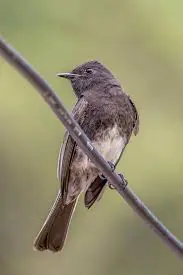
Black Phoebe
Mostly dark charcoal gray, blacker on head, with white belly. Note slim shape, upright posture. Often dips tail down and then up while perched. Juveniles in summer have rusty edges on wing and back feathers.
Black Phoebes use mud to build cup-shaped nests against walls, overhangs, culverts, and bridges. Look for them near any water source from small streams, to suburbs, all the way to the salt-sprayed rocks and cliffs of the Pacific Ocean.
Males and females are similar, but males have somewhat larger plumage and coloration
Sound: sing a long series of repeated tee-hee tee-hoo notes to defend territories and attract mates. During mating and defending territory
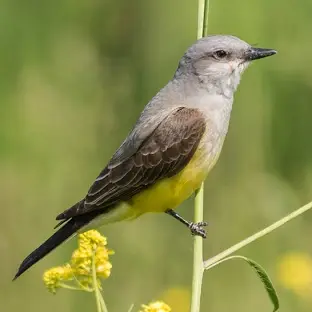
Western Kingbird
Western Kingbirds are gray-headed birds with a yellow belly and a whitish chest and throat.
Large, hefty flycatcher with a bright yellow belly, pale gray head, and whitish throat. Note white edging on outer tail feathers. Sits upright on exposed perches and scans for insects. Note white outer tail feathers and uniform gray throat and chin.
Western Kingbird males and females are sexually monomorphic, meaning they look very similar in plumage, but males have longer and more emarginated outer primaries than female
Sound:
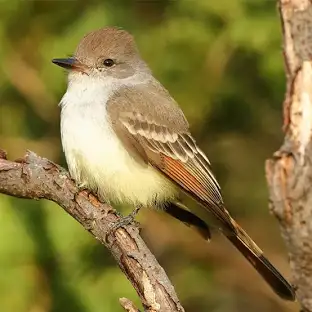
Ash-throated Flycatcher
With its pale lemon belly and cinnamon tail, the Ash-throated Flycatcher is reminiscent of a desert just before sunset.
Has paler yellow body compared to western kingbird (notice the photo its a bit lighter)
Males and females are identical but males are slightly larger and more coloration?
Sound: They make a short and rapid huit call or string them together ...
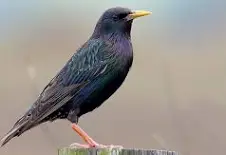
European Starling
Grey-black bird with yellow short pointy beak and iridescent feathers
Covered in white stars in the winter
You can remember the name because it looks like a star LOL
Invasive species in the US
a medium-sized, black songbird with a short tail and triangular wings. They are known for being noisy, social, and gregarious.
They can mimic bird noises
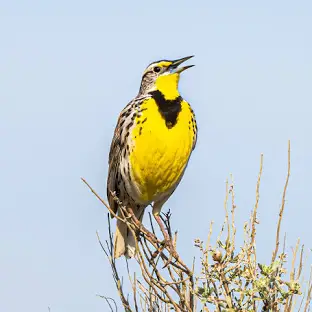
Western Meadowlark
The western meadowlark is a bird with yellow underparts, a black "V" on its breast, and brown upperparts. It has a long, pointed bill and a flute-like song
Males versus females: males have brighter plumage and larger bodies than females
Sound: s a low, bell-like pluk or chupp which they use when disturbed and during courtship and territorial displays.
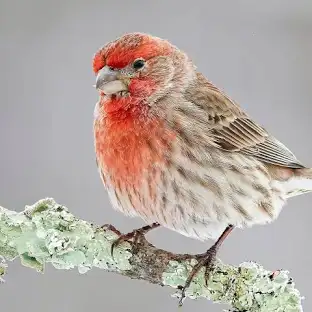
House Finch
small songbirds with large beaks, long heads, and short wings
Adult males are rosy red around the face and upper breast, with a streaky brown back, belly, and tail
Adult females: Grayish-brown with thick, blurry streaks and an indistinctly marked face
Sounds: Found in a wide range of habitats, from arid deserts to open woodlands and shrubby fields
Common in both urban and suburban areas
Extend from the southern edge of Canada through central and southern Mexico
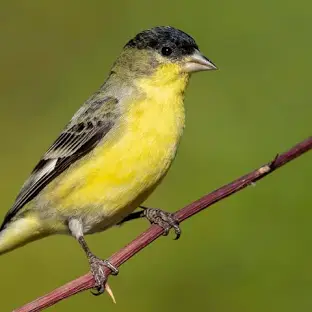
Lesser Goldfinch
lesser Goldfinches are tiny, stub-billed songbirds with long, pointed wings, and short, notched tails.
Black head with yellowish body
Males and females: Lesser Goldfinch males have bright yellow underparts and a glossy black cap, while their backs can be either black or green, depending on their location. Females and immatures are drabber, with olive backs, dull yellow underparts, and black wings marked by two whitish wingbar
Sound: a jumble of clear notes mixed in with wheezes, trills, and stutters, lasting up to 10 seconds.
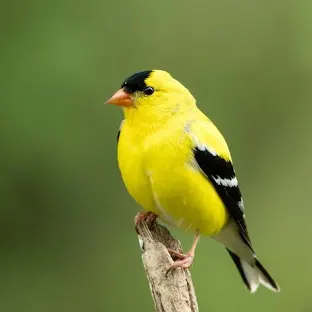
American Goldfinch
a small, seed-eating finch with a short, conical bill and wings that are darker than its body.
Active and acrobatic, often seen in flocks
Fly with a bouncy, undulating pattern
Often call in flight, with calls including “per-chick-o-ree” and “sueweeet”
Forage in weeds, shrubs, and trees, often climbing about acrobatically on plants such as thistles to reach the seeds
Habitat
Weedy fields and floodplains
Cultivated areas, roadsides, orchards, and backyards
Diet
Primarily seeds, including nyjer, black oil sunflower, alder, and aster
Also snack on buds, sap, and the bark of young twigs
In spring, females are greenish yellow with dark wings and tail
Winter: Both sexes are more similar, with brown, olive, and dull yellow-green feathers
IMPORTANT:Female Lesser Goldfinches have a white rectangle on the wings that female American Goldfinches lack. They also have yellow undertail coverts, whereas the undertail coverts on American Goldfinches are white.
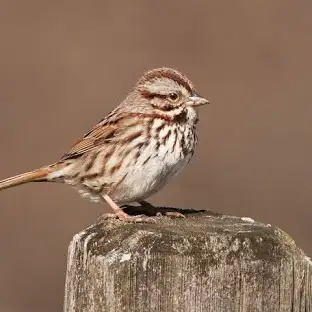
Song Sparrow
From new york, grayish faces and reddish brown markings that can be warm in color. Note thick, triangular mustache or malar stripe.
Females versus males: Both male and female song sparrows are brown with dark streaks on their backs.
They have white undersides with dark streaks that form a central spot on their breasts.
Juveniles are similar to adults but have less distinct face and head stripes.
Sound: a loud, clanking song of 2–6 phrases that typically starts with abrupt, well-spaced notes and finishes with a buzz or trill.
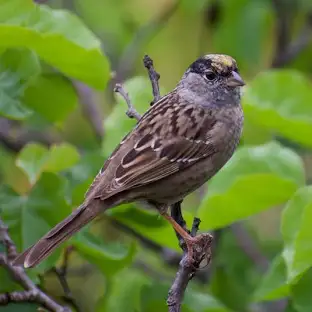
Golden-crowed sparrow
bright yellow-orange crown patch, pale olive upperparts, and gray underparts, with a black-and-white striped face and thin white wingbar. They are active, often seen high in dense trees, and have high-pitched calls and song
Both males and females share similar plumage, with a grayish-brown upperparts and gray underparts.
Head Stripes:
While both sexes have the distinctive gold patch with two adjacent black stripes, males tend to have more strongly contrasting head stripes than females.males are slightly larger and heavier than females, with males also having more strongly contrasting head stripes on average.

White crowned sparrow
While white-crowned sparrows may look ordinary at first glance, their black-and-white-adorned heads, gray breasts and orange-colored bills let you know that these birds are something special
. Males and females look the same, while friendly juvenile white-crowneds feature bold nutmeg brown stripes on top of their heads.
Sound: The most frequently heard include a sharp pink, lower-pitched than the White-throated Sparrow's call. It's ...
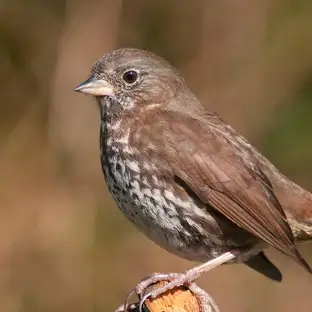
Fox Sparrow
large, chunky sparrows known for their reddish-brown and gray plumage, heavy streaking on their underparts, and a distinctive ground-scratching behavior while foraging.
Males vs females:
Sound: Fox Sparrows sing a sequence of about a dozen rich, whistled notes lasting 2–3 seconds in all, usually from a concealed perch a few feet from the top of
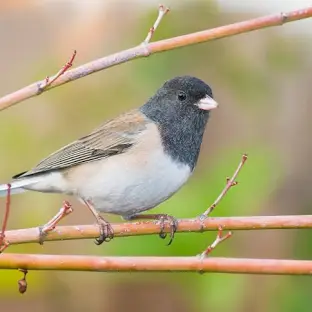
Dark-eyed Junco
Dark-eyed juncos are medium-sized sparrows with rounded heads, stout bills, and long tails, known for their dark eyes, pink bills, and conspicuous white outer tail feathers that flash in flight. They are also known for their geographic variation in plumage
Males vs females:
Sound: musical trill of 7-23 notes that lasts up to 2 seconds.
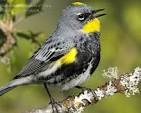
Yellow-rumped Warbler
Yellow-rumped warblers are easily recognized by their bright yellow rump patch, yellow sides, and yellow patches on their throat and crown, with males being more brightly colored than females
Males versus females:
Sound: a slow, soft, sweetly whistled warble or trill.
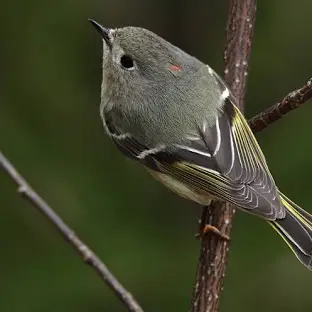
Ruby crowned kinglet
Black and white body with red mohawk head
olive-green birds with a prominent white eyering and white wingbar.
Males versus females: males have red crown patch
Sound: Ruby-crowned Kinglets sing a jumbled but distinctive song that builds to an incredibly loud ending when

Bushtit
Bushtits are small, social, and acrobatic birds with a distinctive appearance: they are tiny, plain gray-brown with large heads, long tails, and short, stubby bills, often found in flocks

Blue-gray gnatcatcher
Blue-gray Gnatcatchers are pale blue-gray birds with grayish-white underparts and a mostly black tail with white edges. The underside of the tail is mostly white. The face is highlighted by a thin but obvious white eyering.
Males versus females
Sound: Both sexes use high-pitched, nasal calls. A sharp, mewing zeee, or chay contact call is uttered in bursts of 2 to 6 notes about a second apart.
House wren
look for a small, brown bird with a short, often cocked-up tail, a slightly curved beak, and a plain, overall grayish-brown appearance with subtle barring on its wings and tail; they are typically found near human habitations, hopping around in dense vegetation, and are known for their energetic, bubbly songs.
Males versus females
Sound:churrs, chatters, rattles, and scolds, often in response to large animals that might be predators.
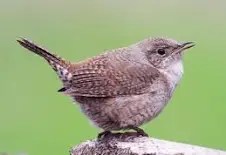
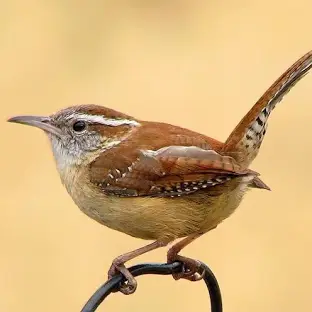
Marsh wren
whitish below and rusty brown above, with black-and-white streaks down its back and a white eyebrow.
Males versus females:
Sound: Songs. Males sing a rapid series of gurgling and buzzy trills. Though each note may only last for 1–2 seconds, they can carry on for up to 20 minutes, hardly ever repeating the same note. Males in the eastern United States sing a more liquid and less harsh song than males in the West.
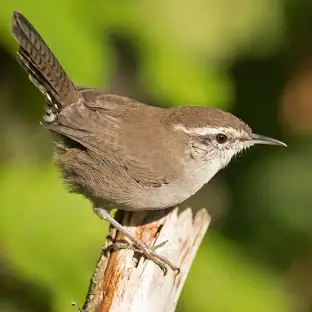
Bewick’s wren
Bewick's Wrens, identified by their bold white eyebrow stripe, longish tails often held upright, and a long slightly curved bill, are known for their energetic behavior and varied vocalizations, primarily found in brushy areas and gardens
Size and Shape:
Medium-sized wren with a slender body.
Long tail, often flicked or fanned.
Long, slightly curved bill.
Plumage:
Subdued brown on the back and wings, with dark barring.
Pale gray-white underparts.
Prominent white eyebrow stripe.
Tail is barred with black and tipped with white spots
Behavior:
Noisy and hyperactive, flicking their tails as they move.
Master vocalists with a variety of short whistles, warbles, burrs, and trills.
Often seen in heavy brush and can be hard to see.
Habitat:
Found in dry brushy areas, chaparral, scrub, thickets, and open woodlands near streams.
They are also at home in gardens and parks in cities and suburbs.
Males versus females:
Sound: plink plink or pee or—from females—sker.
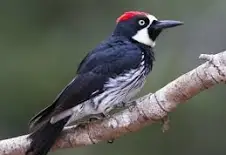
Acorn woodpecker
These striking birds are mostly black above with a red cap, creamy white face, and black patch around the bill.
Sound: Their most common call is a loud, squeaky waka-waka-waka, used for greeting family members, disputing territory boundaries, and squabbling in groups. They also give noisy trills, harsh repeated notes, chatters, and other calls.
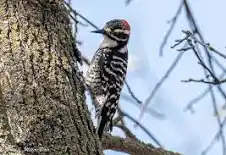
Nuttals Woodpecker
Hairy Woodpeckers are contrastingly black and white. The black wings are checkered with white; the head has two white stripes (and, in males, a flash of red toward the back of the head). A large white patch runs down the center of the black back. Hairy Woodpeckers hitch up tree trunks and along main branches
Males versus females:
Sound: The most common call of the Hairy Woodpecker is a short, sharp peek note very similar to Downy Woodpeckers, but slightly lower pitched and often sounding more
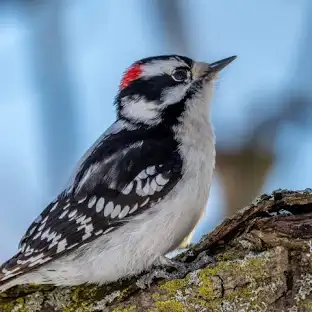
downy woodpecker
Downy Woodpeckers give a checkered black-and-white impression. The black upperparts are checked with white on the wings, the head is boldly striped, and the back has a broad white stripe down the center. Males have a small red patch on the back of the head.
Males versus females:
Sound: somewhat excited string of hoarse, high-pitched notes that descend in pitch toward the end; the call lasts about 2 seconds.
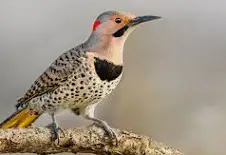
northern flicker
Large woodpecker with a black bib and spotted belly. Males in the East have a red nape, a black whisker, and yellow shafts on the flight and tail feathers.
Males versus females:
Sound: Northern Flickers make a loud, rolling rattle with a piercing tone that rises and falls in volume several times. The song lasts 7 or 8 seconds and is quite ...
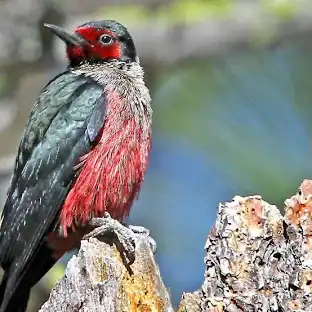
lewis’s woodpecker
This woodpecker often appears all dark, especially from a distance, but in good light its unique color pattern shows. It has a pink belly, a gray collar, a dark green back, and a dark red face. Lewis's Woodpeckers look like a woodpecker, forage like a flycatcher, and fly like a crow.
Males vs females:
Sound: Lewis's Woodpeckers are relatively quiet compared to other woodpeckers. Males give a harsh churr 3–8 times in quick succession primarily during courtship. Males and perhaps females chatter in a series of short squeaks throughout the year. The alarm call given by both males and females is a sharp squeaky burst.

white-breasted nuthatch
White-breasted Nuthatches are gray-blue on the back, with a frosty white face and underparts. The black or gray cap and neck frame the face and make it look like this bird is wearing a hood. The lower belly and under the tail are often chestnut.
Males vs females:
Sound: The White-breasted Nuthatch's most common call is a loud, nasal yank often repeated a few times in a row.
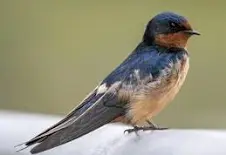
barn swallow
Barn swallows have long, forked tails, dark upper bodies, and pale underbellies. They are often seen flying in sweeping arcs over open fields and water.
Males vs females
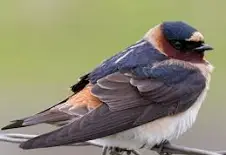
cliff swallow
Compact swallow with pointed, broad pointed wings, a small head, and a squared tail. In good light, adults have metallic, dark-blue backs and pale, cinnamon …
Males vs females:
Sound: Their most common call is a soft chur. They also give a squeak when foraging and a purr-like alarm call when predators approach the colony.
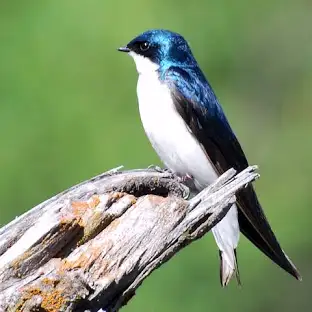
tree swallow
Sharply bicolored, dark above, clean white below. Adults are glossy blue or green above, with dark cap down to level of eye. Juveniles dusky brown above, often have gray-brown wash across chest (Bank Swallow is much more sharply marked on chest).
Males vs females
Sound: Tree Swallow songs are high-pitched and liquid, composed of three sounds—a chirp, a whine, and a gurgle—which they mix and match in a variety of patterns. Both ...
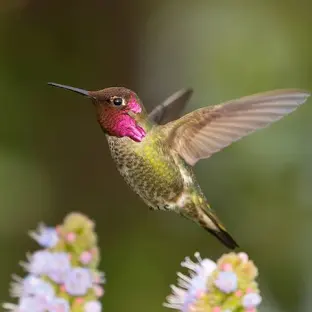
anna’s hummingbird
Anna's Hummingbirds are mostly green and gray, without any rufous or orange marks on the body.
Males vs females:
Sound: Anna's Hummingbirds have a distinctive song that is long for a hummingbird (10 seconds or more). It's a series of buzzes, then a clearer, more tuneful whistle.
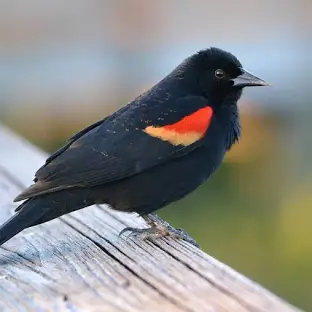
red-winged blackbird
Male Red-winged Blackbirds are hard to mistake. They're an even glossy black with red-and-yellow shoulder badges. Females are crisply streaked and dark …
Males versus females
Sound: Males often sing from a high perch while leaning forward, drooping their wings, spreading their tail feathers, and fluffing their bright shoulder patches to ...

cedar waxwing
Cedar waxwings are small, sleek birds with pale brown heads, gray wings, a black mask edged in white, a pale yellow belly, and a yellow-tipped tail, often seen in flocks, and known for their high-pitched calls
Males versus females
Sound: Cedar Waxwings have two common calls: a high-pitched, trilled bzeee and a sighing whistle, about a half-second long, often rising in pitch at the beginning.
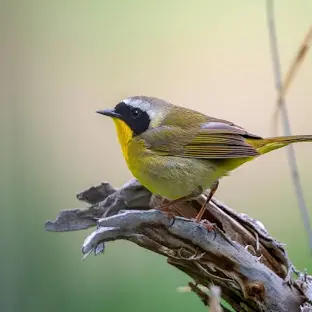
common yellowthroat
Adult males have black mask bordered above by a white band. Females and immatures are duller but always have contrasting yellow throat and undertail coverts.
Males versus females:
sound : The male sings a distinctive witchety-witchety-witchety song, about 2 seconds long, to defend the territory and attract females.
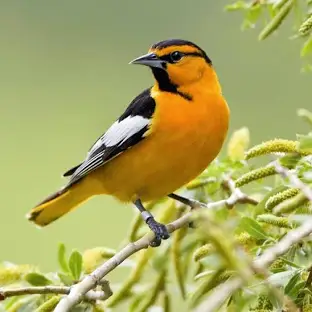
bullock’s oriole
Adult males are bright orange with a black back and large white wing patch. The face is orange with a black line through the eye and a black throat. Females and …
Males versus females:
Sound: Bullock's Oriole songs are about 3 seconds long, composed of rich whistled notes interspersed with rattles, often introduced by gruff scratchy notes.
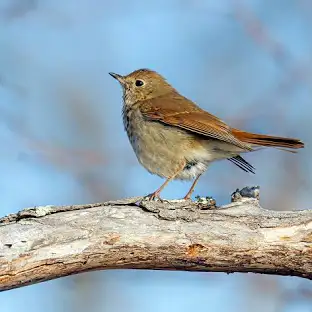
hermit thrush
The Hermit Thrush is rich brown on the head and back, with a distinctly warm, reddish tail. The underparts are pale with distinct spots on the throat and smudged spots on the breast. With a close look you may see a thin pale eyering (not a bold one). Hermit Thrushes hop and scrape in leaf litter while foraging.
Males vs females:
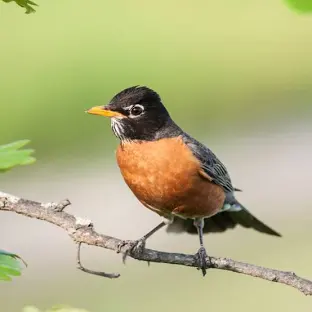
american robin
You can identify an American robin by its red breast, yellow bill, and gray back. They are large songbirds with long legs and tails
Males versus females
Sound: American Robins often make a mumbled cuck or tuk to communicate with each other or a sharp yeep or peek as an alarm call. They also make a repeated chirr that rises in volume and can sound like a laugh or chuckle.
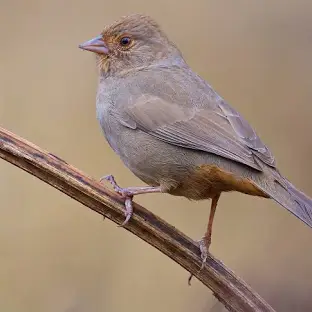
california towhee
California Towhees are essentially large sparrows, with a sparrow's short, rounded wings, long tail, and thick, seed-cracking beak—but towhees are larger and bulkier. The long tail and short wings can give this bird an ungainly look in flight
Males versus females:
Sound: The most frequently heard sound from California Towhees is a clear, metallic chip, similar to the sound of a Northern Cardinal (and also to the California ground squirrel). Males and females may call intermittently or in a monotonous string of chips every couple of seconds.
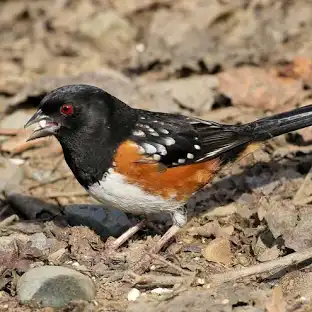
spotted-towhee
Male Spotted Towhees have jet-black upperparts and throat; their wings and back are spotted bright white. The flanks are warm rufous and the belly is white.
Males versus females:
Sound: . Spotted Towhees make a catlike mew call, a little more than a half-second long. It seems to be used for scolding as well as by perched or foraging birds.

wild turkey
Wild turkeys are large, ground-dwelling birds with a dark, almost black body, red head and neck, and a long, feathered tail, with males (gobblers) displaying a large fan-like tail when strutting
Males versus females:
Sound: Wild turkey sounds include gobbling (loud, throaty sounds from males), yelping (common hen calls and can be used to signal flock reassembly), and various other calls like clucks, purrs, cutting (alarm/excited), and tree yelps
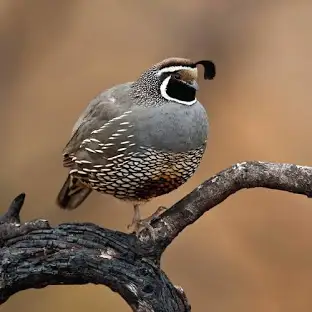
California quail
California quail are easily identified by their short, curved, teardrop-shaped crest (or topknot) that droops forward and their scaled belly pattern, with males having a black face outlined in white, while females and juveniles have a more subdued grey-brown plumage
Males versus females:
Sound: The California Quail's main call consists of three syllables and sounds like the bird is saying Chi-ca-go. It's usually given when an individual is separated from its group or mate, as well as while a covey is on the move or preparing to move.

morning dove
Mourning doves are blue-gray birds with pointed tails and small heads. They are about the size of a robin and have a soft cooing sound
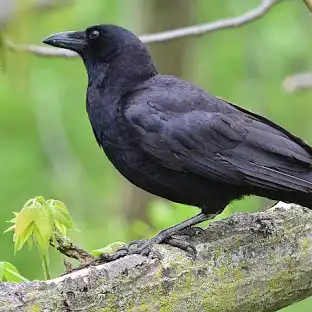
american crow
A large, long-legged, thick-necked bird with a heavy, straight bill. In flight, the wings are fairly broad and rounded with the wingtip feathers spread like fingers. The short tail is rounded or squared off at the end.
Males versus females:
Sound: loud caws lol
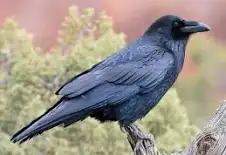
common raven
Not just large but massive, with a thick neck, shaggy throat feathers, and a Bowie knife of a beak. In flight, ravens have long, wedge-shaped tails.
Sound: The most recognizable call of a Common Raven is a deep, throaty "croak" or "kraa," which is much more musical and guttural than the harsh "caw" of an American Crow
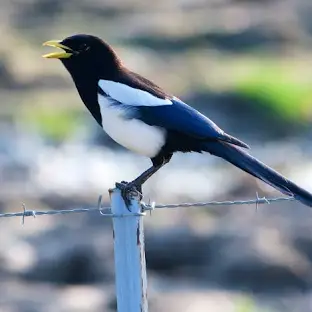
yellow-billed magpie
The yellow-billed magpie (Pica nuttalli) is a striking black-and-white bird, easily identified by its long tail, bright yellow bill, and yellow around its eyes, found exclusively in California's central valley and foothills
Males versus females:
Sound: A raucous qua-qua-qua and a querulous quack.

california scrub-jay
The California scrub-jay is a medium-sized, lanky jay with a long tail, a stout, hooked bill, and distinctive features, including a bright blue head, wings, and tail, a gray-brown back, and pale underparts with a partial blue necklace
Males versus females:
Sound: Scrub-jays often clack their bill mandibles together to make a sharp rapping. Their wings make a whooshing sound on takeoff, and they exaggerated this during altercations.
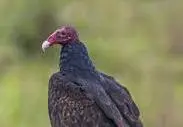
Turkey Vulture
Cathartes aura, large birds with dark feathers and a characteristic wobbly flight style.
Turkey vultures are large birds with dark brown or black feathers, a red head, and a long tail. They have a distinctive "wobbly" flight style and are known for soaring in a shallow "V
Most of their vocalizations come down to a form of low, guttural hiss made when they are irritated or vying for a better spot on a carcass. They also may give a low, nasal whine while in flight.
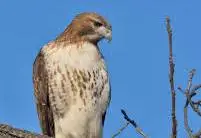
Red-tailed Hawk
Buteo jamaicensis, known for its rich brown coloring and hoarse scream.
Most Red-tailed Hawks are rich brown above and pale below, with a streaked belly and, on the wing underside, a dark bar between shoulder and wrist. The tail is …
Males vs females
Sound:
Adults make a hoarse, screaming kee-eeeee-arr. It lasts 2-3 seconds and is usually given while soaring. During courtship, they also make a shrill chwirk, sometimes giving several of these calls in a row.
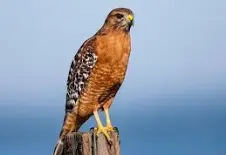
red-shouldered hawk
The red-shouldered hawk, a medium-sized buteo, is identifiable by its reddish or rufous shoulders, a black-and-white checkered wing pattern, and a tail with narrow white bands
Males vs females:
Sound: Call a loud "kee-aah," with second note descending in pitch. Often given repeatedly.
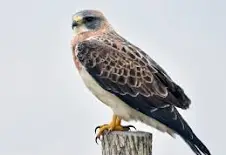
swainson’s hawk
Endangered
These elegant gray, white, and brown hawks hunt rodents in flight, wings held in a shallow V, or even run after insects on the ground.
Males versus females:
Sound:Calls. Adults make a shrill kreeeeee alarm call when perched or in flight, often in response to intruders at the nest. The piercing call lasts 2–3 seconds, fading at the end. The female Swainson's Hawk also gives a shorter, lower-pitched version of the call when the male brings food to the nest.

cooper’s hawk
A medium-sized hawk with the classic accipiter shape: broad, rounded wings and a very long tail. · Color Pattern. Adults are steely blue-gray …
Males versus females:
Sound: Cooper's Hawks tend to be silent. The most common call is a loud, grating cak-cak-cak, 2-5 seconds long, given by both sexes in defense of the nest.
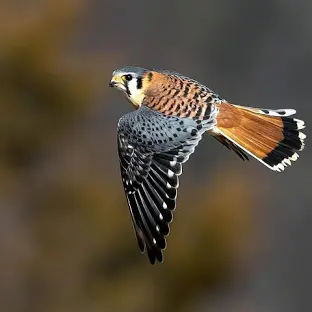
American kestrel
Small falcon with a small head. Adult males are rusty above with slate-blue wings and two black slashes on the face. Often bobs its tail while perched.
2) sound: American Kestrels have a fairly limited set of calls, but the most common one is a loud, excited series of 3-6 klee! or killy! notes lasting just over a second.
3) males versus females:
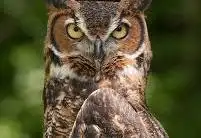
great-horned owl
Great horned owls are large owls with prominent ear tufts, mottled gray-brown feathers, and a white throat patc
Sound: The quintessential "whooo" owl call, often compared to a foghorn, is that of the Great Horned Owl, a North American owl known for its deep, territorial hooting, along with other sounds like screams, growls, and bark
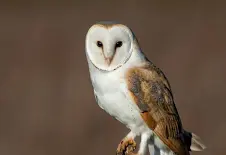
Barn owl
pale overall with dark eyes. They have a mix of buff and gray on the head, back, and upperwings, and are white on the face, body, and underwings. When seen at night they can appear all white. American Barn Owls nest and roost in cavities, abandoned barns and other buildings, and dense trees.
Males vs females
Sound: A softer, more wavering version of this is termed a purring call. Males use it to invite a female to inspect a nest site, and females use it to beg for food ...
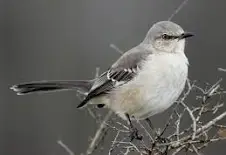
Northern Mockingbird
Mimus polyglottos, a medium-sized songbird known for its ability to mimic other sounds.
a medium-sized songbird with gray-brown feathers, a long tail, and a slightly downward-curved bill
small heads, a long, thin bill with a hint of a downward curve, and long legs. Their wings are short, rounded, and broad, making the tail seem particularly long in flight.
the birds look alike except the female has a little less white in her feathers and is slightly smaller than the male.